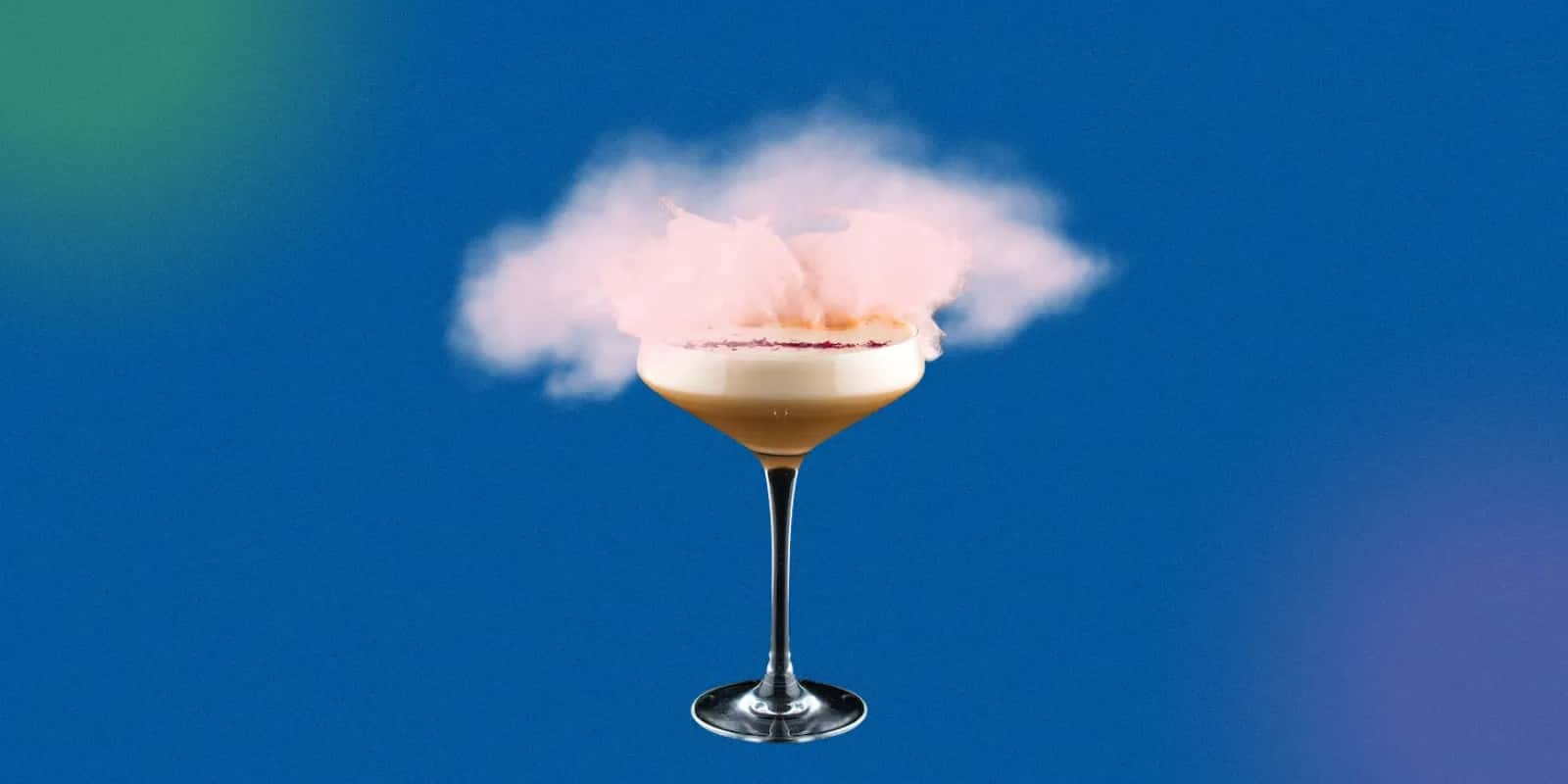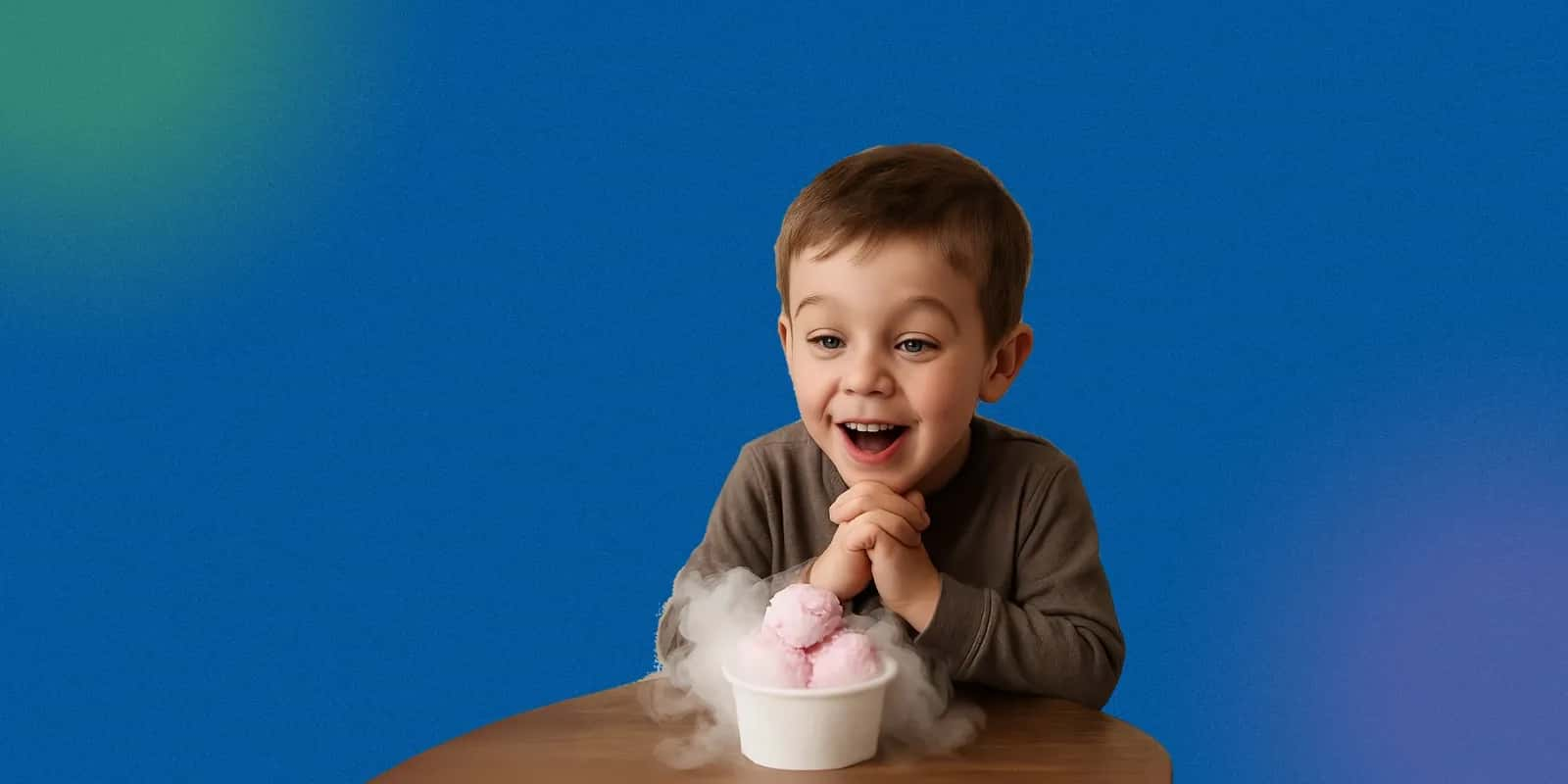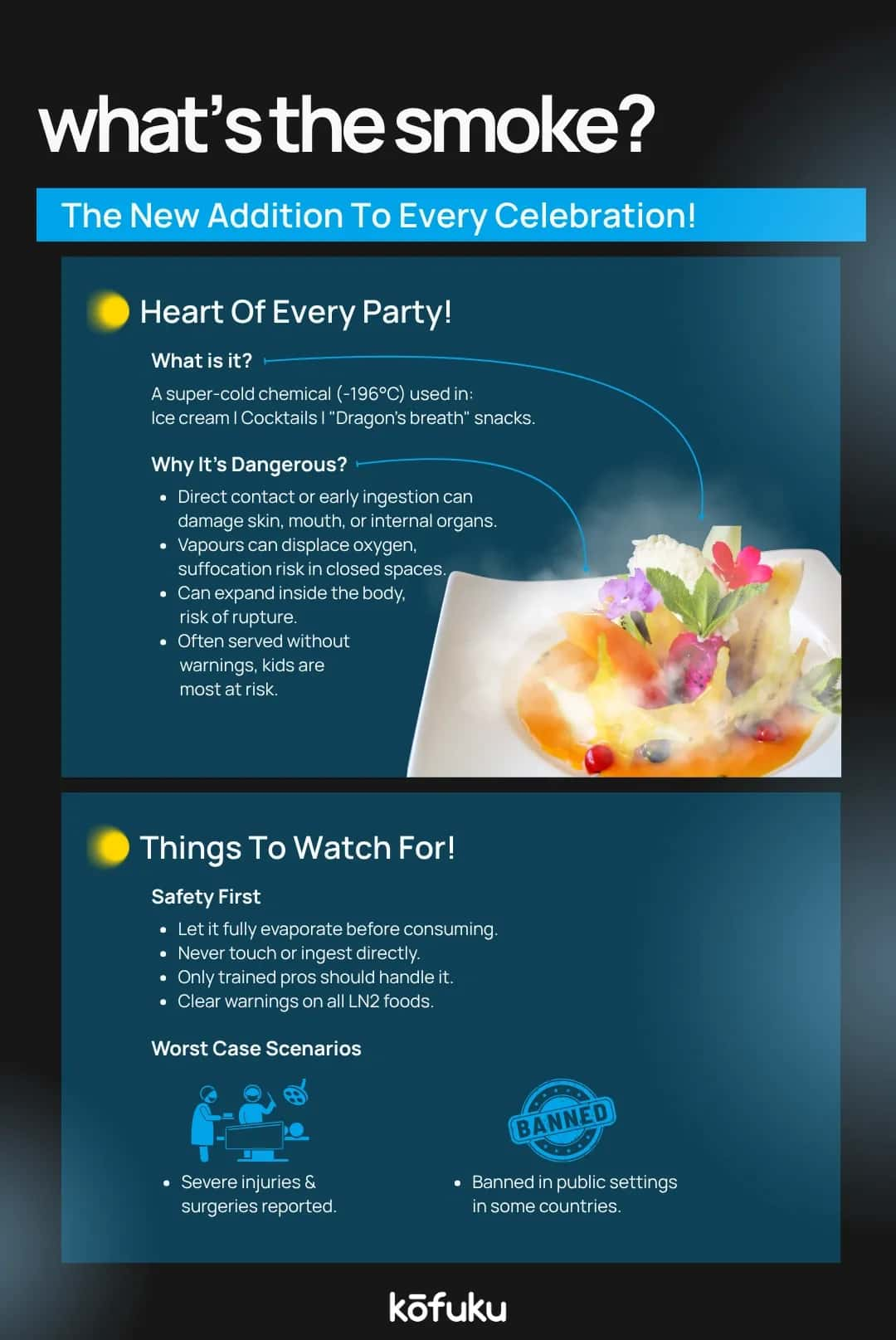Dangers of Using Smoky Liquid Nitrogen in Food

Introduction
Have you ever wanted to try those really dramatic smoky desserts or drinks that “breathe” clouds of fog when served? Sure, they look absolutely stunning, but do you know what the equally dangerous truth of these foods is?
From nitrogen biscuits to new trendy snacks labelled as a “Dragon’s Breath”, food made with liquid nitrogen has dramatically risen in popularity over the past decade, particularly with youngsters and social media influencers looking for the next great Instagram hit.
Whether it's smoky ice cream or nitrogen biscuits, there's something captivating about these foods, not to mention how they're presented.
But this smoky creation comes with a hidden danger that most people seem to overlook or ignore. The use of liquid nitrogen is allowed in foods, especially when it is poured onto the food just before serving, but it can have serious implications for your health when it is not used with extreme care.
This article will help you understand why foods made with liquid nitrogen are not only dangerous but can also cause life-altering injuries.
From health implications and warnings to real-world accidents and regulation gaps, here's everything you need to know about nitrogen biscuits and other foods made with liquid nitrogen.
Liquid Nitrogen in Food: How it Affects Your Health?
While liquid nitrogen is classified as non-toxic, its freezing characteristics can cause serious physical harm; after all, it is basically nitrogen gas cooled to a temperature of –196 °C.
- Freezing injuries:
Any direct contact of liquid nitrogen with the skin or food that enters the mouth, touches the eyes, or reaches the throat can result in the instant freezing of soft tissue.
This is more than just irritation - we are talking about cases of second-degree burns and frostbite in just seconds if you’re not careful.
- Ingestion hazards:
Ingesting liquid nitrogen before it evaporates completely can lead to internal freezing. What is more troubling is that as liquid nitrogen vaporises in the stomach, it expands enormously, which can lead to barotrauma, perforation, or gastric rupture.
- Respiratory hazards:
Inhaling vapour from a liquid‑nitrogen dessert or drink can cause airway irritation, asthma attacks, or even lung inflammation. Nitrogen gas can also displace oxygen, causing asphyxia.

FDA Warning Against Liquid Nitrogen
In August-September 2018, the U.S. Food and Drug Administration (FDA) issued a safety alert advising against consuming foods or drinks prepared using liquid nitrogen at the point of sale, as this is the most dangerous way to use it.
By this time, food products named “Dragon’s Breath,” “Heaven’s Breath,” and “Nitro Puff” were appearing frequently in malls, fairs, and kiosks.
The FDA asked people not to eat, drink, or handle these products if the item is made for immediate consumption, thereby causing catastrophic injury.
According to the FDA, it's less concerning if liquid nitrogen was used earlier in the process, like flash-freezing ice cream, and completely evaporated before it was sold.
In the 2018 Food Code interpretation, the FDA encouraged retailers to have staff training, labelling, checks for complete evaporation, ventilation, and warning signs before using liquid nitrogen.
Mishaps in The Past
UK cocktail disaster
In October 2012, an 18-year-old woman visited Oscar’s Wine Bar in Lancaster, where she drank a "Nitro-Jägermeister" cocktail that contained residual liquid nitrogen.
Unfortunately, she suffered a gastric perforation and had to have emergency surgery to remove a large part of her stomach. The establishment was then fined £100,000.
This public health risk prompted calls for the regulation of liquid nitrogen cocktails.
Food truck disasters
There are multiple recorded incidents across the world, specifically involving "Dragon's Breath", a popular sugary snack containing cereal frozen with liquid nitrogen:
- A teenage girl in Malaysia burned her thumb while handling this snack.
- In Singapore, multiple people sustained burns from vapour contact.
- In India, customers suffered gastric burns requiring hospital treatment after consuming nitrogen-coated products too quickly.
- A fairground incident included a 13-year-old needing emergency surgery for a gastric perforation after consuming liquid nitrogen.
Workplace incidents
The dangers of liquid nitrogen are not limited to novelty foods, as noted by a federal investigation into an incident that occurred in a Georgia poultry plant in January 2021. Six people died of asphyxiation in a confined space because of a liquid nitrogen leak.
Stringent Laws Needed to Stop the Use of Liquid Nitrogen in the Industry
The above events illustrate a significant gap in regulation and public safety. While some food safety agencies have provided guidance, the enforcement of these guidelines differs greatly and sometimes is overlooked entirely.
Some specific policy suggestions for safety include:
- Legal prohibitions:
Prohibit the use of liquid nitrogen in food at the point of sale, or wait until the liquid nitrogen has evaporated completely.
- Staff training requirements:
Broad, in-depth training on safe use, equipment operation, temperature control expectations, and ventilation while using or handling liquid nitrogen.

- On-site safety plan:
Establish protocols for on-site verification of full evaporation, Ventilation, and verified monitoring of safe oxygen levels. Also, ensure that food is not served until it has been confirmed to be at a safe temperature.
- Safety warning signs and labels:
Clear warnings must be provided before releasing any liquid nitrogen-infused product to the public; for example, "WARNING: Do not eat until nitrogen fog has evaporated."
- Penalties for non-compliance:
There should be fines, suspension, revocation of food licences, or criminal charges for negligent or irresponsible service that causes physical harm.
- Public health surveillance:
Local public health authorities should maintain a log, and victims should be encouraged to report any injury to public health and safety agencies, such as the FDA or MedWatch, so that accidents involving liquid nitrogen don’t occur frequently.
Takeaways
Nitrogen biscuits, drinks, and other nitrogen treats may look interesting and entertaining, but are they really worth putting your life in danger?
Sure, these smoky desserts and drinks have a theatrical effect that is ideal for social media, but they come with hidden dangers that can lead to burns, damage, and in extreme cases, stomach ruptures.
If you look at it seriously, these dining experiences are indeed risky and pose a significant health hazard.
If you ever want to try these food items with liquid nitrogen on the streets, make sure to:
- Never eat or drink it until the vapour has completely disappeared.
- Don't touch or handle food that is still producing vapour.
- Be especially cautious with children who are drawn to these foods.
Liquid nitrogen has a place in laboratory science and professional kitchens, but not in food items, as the harmful effects considerably outweigh the fun. Be safe and careful when it comes to nitrogen biscuits or any other nitrogen-infused foods.

FAQs
Q. Is it safe to eat food prepared with liquid nitrogen?
A. Eating food prepared with liquid nitrogen is considered safe if adequate handling and preparation protocols are followed.
Nevertheless, if nitrogen is not completely evaporated or if food is not handled and stored correctly, it can lead to severe conditions such as explosions, frostbite or burns.
Q. What happens is you accidentally ingest liquid nitrogen?
A. Ingesting liquid nitrogen leads to internal damage like burns to the mouth, throat and digestive tract or rupture, perforation, or barotrauma.
It further leads to respiratory issues because nitrogen can displace oxygen inside the lungs. In rare cases, ingesting liquid nitrogen also causes death.
Q. Why is liquid nitrogen banned in some restaurants?
A. Liquid nitrogen is banned in many places, including restaurants, because of the risk related to its usage, like explosions, burns, and other respiratory issues. Some jurisdictions also banned it because of the risks of misuse of liquid nitrogen.
Q. Are there long-term effects of inhaling nitrogen vapour?
A. Inhaling nitrogen vapour leads to different types of respiratory issues, like, coughing, shortness of breath, wheezing, etc. More prolonged exposure to liquid nitrogen further causes severe health implications like failure of the respiratory tract, coma or death.
Q. What precautions should be taken when using liquid nitrogen?
A. There are some precautions to consider while using liquid nitrogen:
- Use protective gloves
- Use goggles as well as face-mask
Moreover, you must also make sure that the area is fully ventilated and has a fire extinguisher on the premises. It is important to use liquid nitrogen with proper measures to avoid any adverse effects.

10 Migraine Misunderstandings That You Need to Clear

Catch a Cold: Debunking Common Myths

Potassium-Rich Diet Tips to Boost Your Nutrient Levels

The Sadhguru Diet - Myth or Fact?

10 Food Items for the Hot and Humid Summer Months


